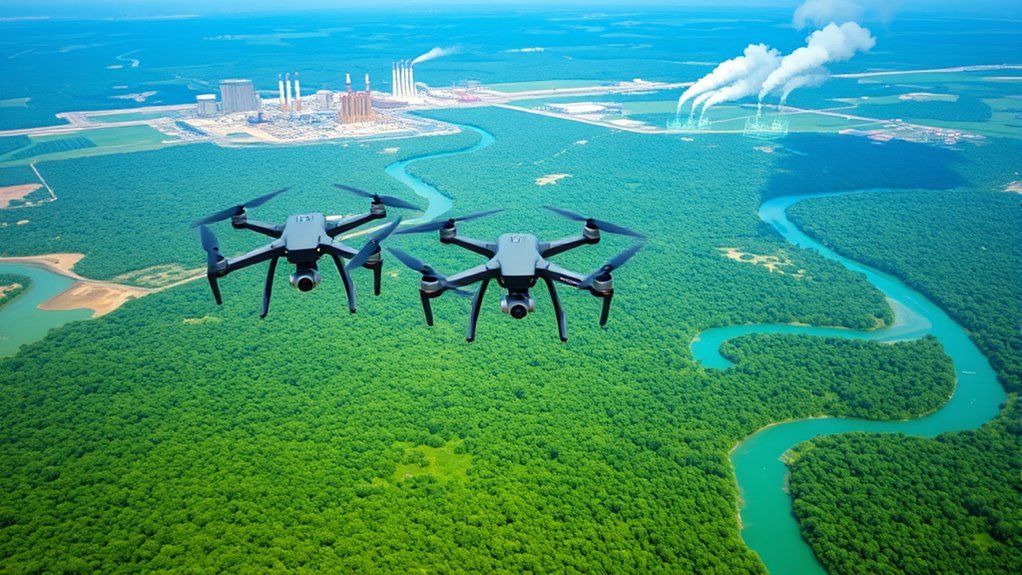When building autoencoders for anomaly detection, you’ll start by preparing your data through normalization and careful feature selection to enhance learning. Design your architecture with an appropriate bottleneck size and select activation functions like ReLU for better convergence. Use loss functions such as MSE to highlight reconstruction errors, and apply robust training strategies including regularization and hyperparameter tuning. Implement calibrated thresholds to distinguish anomalies accurately. These steps create a strong foundation for detecting anomalies effectively; further insights will refine your approach.
Understanding Autoencoder Fundamentals

Autoencoders are a type of neural network designed to learn efficient data representations by encoding input into a compressed format and then reconstructing it with minimal loss. To grasp autoencoder basics, you must understand its two main components: the encoder and the decoder. The encoder compresses the input data into a lower-dimensional latent space, capturing essential features while discarding noise. This latent space acts as a bottleneck, forcing the network to learn meaningful abstractions. The decoder then reconstructs the original input from this compressed representation, aiming to minimize reconstruction error. By mastering these fundamentals, you gain the freedom to manipulate and optimize autoencoders for various applications, including anomaly detection, where deviations from normal patterns are identified through reconstruction discrepancies.
Types of Autoencoders for Anomaly Detection

You’ll encounter various autoencoder types tailored for anomaly detection, ranging from basic variants like undercomplete and denoising autoencoders to advanced models such as variational and convolutional autoencoders. Each type offers distinct mechanisms for learning data representations and identifying deviations. Understanding their structural differences helps you select the right model for your specific anomaly detection task.
Basic Autoencoder Variants
Understanding the different types of autoencoders is essential when tailoring anomaly detection models to specific data characteristics and problem requirements. The basic architecture consists of an encoder compressing input data into a latent representation and a decoder reconstructing it. This structure enables the model to learn normal data patterns, flagging anomalies through poor reconstruction. One common variant is the Denoising Autoencoder, which adds noise to inputs during training, forcing the network to learn robust features and effectively perform noise reduction. This approach enhances anomaly detection by improving resilience to corrupted or incomplete data. By mastering these fundamental variants, you gain the freedom to select or customize models that align with your dataset’s complexity and noise levels, ensuring precise and reliable anomaly identification without overcomplicating the architecture.
Advanced Autoencoder Models
Although basic autoencoder variants provide a solid foundation for anomaly detection, more complex data patterns often require advanced models to capture subtle deviations effectively. You’ll want to explore variational autoencoders for probabilistic modeling, deep convolutional autoencoders for spatial feature extraction, and recurrent autoencoders for sequential data. Hybrid autoencoders combine strengths, while generative adversarial autoencoders enhance robustness. Transfer learning autoencoders leverage pre-trained knowledge, and unsupervised learning autoencoders excel without labeled data.
| Model Type | Strength | Application Focus |
|---|---|---|
| Variational Autoencoders | Probabilistic latent space | Anomaly likelihood |
| Deep Convolutional Autoencoders | Spatial feature extraction | Image-based anomalies |
| Recurrent Autoencoders | Temporal pattern recognition | Time-series anomalies |
Selecting the right advanced model lets you detect anomalies with improved precision and adaptability.
Preparing Data for Autoencoder Training

Before training an autoencoder, it’s crucial to prepare your data meticulously to guarantee the model learns meaningful representations. Start with data normalization and scaling techniques to ensure consistent feature ranges, which improves convergence. Apply feature selection to reduce irrelevant or redundant variables, enhancing model focus. Handle outliers carefully—they can distort learning—using methods like trimming or robust scaling. For categorical variables, implement categorical encoding to convert them into numeric formats. If working with time series data, perform time series preprocessing such as resampling or windowing. Employ noise reduction to improve signal clarity. Split your dataset into training, validation, and test sets to evaluate performance effectively. Consider dimensionality reduction and data augmentation to enrich training data and prevent overfitting, ultimately empowering your autoencoder to detect anomalies robustly.
Designing the Autoencoder Architecture
When designing your autoencoder architecture, you’ll need to carefully configure the layers to balance complexity and generalization. Choosing appropriate activation functions is essential for capturing non-linear patterns in your data. Additionally, optimizing the bottleneck size directly impacts the model’s ability to reconstruct inputs and detect anomalies effectively.
Layer Configuration Strategies
Since the architecture of your autoencoder directly impacts its ability to learn meaningful representations, carefully configuring its layers is essential. Begin by selecting appropriate layer types—commonly dense or convolutional—based on your data’s nature. Adjust layer depth to balance model capacity and overfitting risk; deeper networks can capture complex patterns but may require stronger regularization. Define layer width to control feature abstraction granularity, gradually narrowing toward the bottleneck. Apply layer regularization techniques like dropout or weight decay to enhance generalization. Design layer connections thoughtfully; skip connections can preserve information flow and ease training. Incorporate layer normalization to stabilize activations and speed convergence. By systematically tuning these parameters, you guarantee your autoencoder effectively encodes normal behavior while maintaining flexibility to detect anomalies with precision.
Activation Functions Selection
Although layer configuration sets the structural foundation of your autoencoder, choosing the right activation functions is equally critical for enabling nonlinear transformations and capturing complex data patterns. Conducting an activation functions comparison helps you discern how ReLU, Sigmoid, Tanh, and Leaky ReLU influence learning dynamics and reconstruction accuracy. Impact analysis reveals that ReLU often accelerates convergence and mitigates vanishing gradients, while Sigmoid and Tanh excel in bounded output scenarios but risk saturation. Leaky ReLU balances these effects, preserving gradient flow in negative domains. Ultimately, your selection depends on data characteristics and anomaly detection goals. By systematically evaluating activation functions through impact analysis, you empower your autoencoder to model intricate distributions effectively, enhancing anomaly detection reliability without compromising architectural freedom or performance.
Bottleneck Size Optimization
Activation functions shape how your autoencoder transforms data, but the architecture’s capacity to compress and reconstruct hinges greatly on the bottleneck size. The bottleneck layer determines the level of dimensionality reduction, directly impacting feature extraction and data representation. If the bottleneck is too narrow, essential information may be lost, increasing reconstruction error and reducing anomaly detection accuracy. Conversely, an excessively large bottleneck risks overfitting and inflates model complexity, hindering training efficiency. To optimize the bottleneck size, you should balance minimizing reconstruction error while maintaining compact, meaningful representations. Employ techniques like cross-validation or monitoring validation loss to find this equilibrium. Ultimately, fine-tuning the bottleneck size empowers your model to efficiently extract relevant features, improving anomaly detection without sacrificing generalization or computational resources.
Choosing the Right Loss Function
When designing an autoencoder for anomaly detection, selecting the appropriate loss function directly impacts the model’s ability to distinguish normal from anomalous data. You’ll encounter various loss function types—mean squared error (MSE), mean absolute error (MAE), and binary cross-entropy—each influencing reconstruction sensitivity differently. Performing an impact analysis helps determine which loss aligns best with your data distribution and anomaly characteristics. For continuous data, MSE emphasizes larger reconstruction errors, making anomalies more detectable, while MAE provides robustness against outliers. Binary cross-entropy suits binary or probabilistic inputs. Choosing the right loss function ultimately shapes how your model prioritizes reconstruction accuracy versus tolerance to noise, granting you freedom to tailor detection sensitivity. Therefore, understanding these trade-offs is essential for crafting an effective anomaly detection autoencoder. Iterative refinement techniques from prompt engineering can similarly be applied to optimize model performance through continuous tuning.
Training Strategies and Hyperparameter Tuning
Since the effectiveness of an autoencoder depends heavily on its training process, you must carefully select strategies and tune hyperparameters to optimize performance. Begin by implementing robust training techniques, including data augmentation, to enhance the model’s ability to generalize. Employ model regularization methods such as dropout or weight decay to prevent overfitting. Use advanced optimization algorithms like Adam or RMSprop to accelerate convergence. Hyperparameter optimization is critical; systematically explore learning rates, batch sizes, and layer configurations using grid search or Bayesian optimization. Establish rigorous validation strategies, such as cross-validation, to evaluate model stability and guide tuning decisions. By integrating these components, you’ll guarantee your autoencoder is well-trained, adaptable, and finely calibrated for effective anomaly detection in diverse data environments. Crafting clearly defined goals for your training process will further refine model performance and ensure alignment with your specific detection objectives.
Evaluating Autoencoder Performance
Although training your autoencoder is essential, analyzing its performance is equally important to secure reliable anomaly detection. You’ll want to apply rigorous evaluation techniques and leverage appropriate performance metrics to confirm your model effectively distinguishes anomalies from normal data patterns. Focus on these key aspects:
- Reconstruction error analysis to quantify deviations between input and output.
- Use of ROC-AUC and Precision-Recall curves for evaluating classification capability.
- Cross-validation to test generalization across different data subsets.
- Confusion matrix examination to understand false positives and false negatives.
Implementing Thresholds for Anomaly Detection
Determining an appropriate threshold is critical for transforming your autoencoder’s reconstruction errors into actionable anomaly detections. You start by analyzing the distribution of anomaly scores—typically the reconstruction errors—on a validation dataset representing normal behavior. Threshold calibration involves selecting a cutoff that balances sensitivity and specificity, often using statistical methods like setting the threshold at a percentile (e.g., 95th) of the normal reconstruction error distribution. Alternatively, you can optimize the threshold based on performance metrics such as the F1 score or ROC curve analysis. Remember, an improperly calibrated threshold either misses anomalies or triggers excessive false positives, limiting your system’s reliability. By implementing a precise, data-driven threshold calibration, you empower your autoencoder to autonomously distinguish between normal variations and true anomalies, granting you effective control over your detection process.
Real-World Applications and Use Cases
With a well-calibrated threshold in place, your autoencoder is ready to be applied across various real-world scenarios where anomaly detection is essential. You can leverage its capabilities in:
- Industrial applications for predictive maintenance, identifying manufacturing defects before failures occur.
- Healthcare monitoring to detect unusual patient signs, enabling early intervention.
- Financial fraud detection by flagging irregular transaction patterns and suspicious customer behavior.
- Network security through spotting anomalies in traffic that indicate cyberattacks or breaches.
Additionally, environmental monitoring benefits from detecting abnormal sensor readings, helping track ecosystem changes. Deploying autoencoders in these domains enhances efficiency and security, empowering you to maintain operational integrity and respond proactively to unexpected events. This flexibility lets you tailor solutions that align with your freedom to innovate and adapt. Effective implementation requires clear and specific prompts to ensure accurate anomaly detection and minimize ambiguity in critical decision-making processes.



